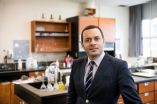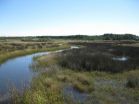Experiential avoidance increases PTSD risk following child maltreatment
2014-03-05
(Press-News.org) Child abuse is a reliable predictor of post-traumatic stress disorder, but not all maltreated children suffer from it, according to Chad Shenk, assistant professor of human development and family studies, Penn State, who examined why some maltreated children develop PTSD and some do not.
Shenk and his research team found that adolescent girls who experienced maltreatment in the past year and were willing to talk about their painful experiences and their thoughts and emotions, were less likely to have PTSD symptoms one year later. Those who tried to avoid painful thoughts and emotions were significantly more likely to exhibit PTSD symptoms down the road. The researchers report their results in the current issue of Development and Psychopathology.
"Avoidance is something we all do," said Shenk. "Sometimes it is easier not to think about something. But when we rely on avoidance as a coping strategy…that is when there may be negative consequences."
Approximately 40 percent of maltreated children develop PTSD at some point in their lives. Shenk sought to identify the factors that kept the remaining 60 percent from experiencing the disorder.
"Children and adolescents react very differently to abuse, and we don't yet know who is going to develop PTSD and who won't," said Shenk. "What factors explain who will develop PTSD and who will not? This study attempted to identify those causal pathways to PTSD."
One theory holds that PTSD is caused by dysregulation in multiple neurobiological processes, including cortisol deficiencies or heightened suppression of respiratory sinus arrhythmia -- each of which affects how individuals can remain calm during a time of stress.
There are also psychological theories, which include experiential avoidance, the tendency to avoid negative feelings like fear, sadness or shame. Shenk's study tested these theories by creating one statistical model that included them all to see which factors best accounted for PTSD symptoms.
"It would be inappropriate to say that these are competing theories, but in the literature they are often treated that way," he said. "Investigators are actually focused on different levels of analysis, one neurological and one psychological, and I think these processes are related."
At three different points over two years, Shenk and his research team examined girls who suffered from at least one of the three types of child maltreatment -- physical abuse, sexual abuse or neglect -- during the previous year. The 51 maltreated adolescent girls were compared to 59 adolescent girls who had not experienced maltreatment.
Figuring out which processes conferred the greatest risk for PTSD could provide a basis for prevention and clinical intervention programs, Shenk said.
"If we can find what the cause or risk pathway is, then we know what to target clinically," he said.
INFORMATION:
Also working on this project were Frank Putnam, professor of psychiatry, University of North Carolina; Joseph Rausch, associate professor of pediatrics, and James Peugh, assistant professor of pediatrics, University of Cincinnati College of Medicine; and Jennie Noll, professor of human development and family studies, Penn State, and director of research and education, Network on Child Protection and Well-Being
A University Research Council Award from the University of Cincinnati, an Institutional Clinical and Translational Science Award and an award from the National Institute of Child Health and Human Development supported the project.
ELSE PRESS RELEASES FROM THIS DATE:
Can low-dose interferon prevent relapse of hepatitis C virus infection?
2014-03-05
New Rochelle, NY, March 5, 2014—Chronic hepatitis C virus (HCV) infection can lead to serious diseases such as cirrhosis and cancer of the liver, so viral clearance and prevention of relapse are important treatment goals. Low-dose oral interferon may reduce the risk of HCV relapse in patients with mild liver fibrosis according to a study published in Journal of Interferon & Cytokine Research, a peer-reviewed publication from Mary Ann Liebert, Inc., publishers. The article is available free on the Journal of Interferon & Cytokine Research website.
In "A Double-Blind Randomized ...
ASTRO white paper provides guidance for optimal quality, safety of HDR brachytherapy
2014-03-05
Fairfax, Va., March 5, 2014— The American Society for Radiation Oncology (ASTRO) has issued a new white paper, "A review of safety, quality management, and practice guidelines for high-dose-rate brachytherapy," that recommends specific guidance to follow in the delivery of high-dose-rate (HDR) brachytherapy to improve quality and patient safety, according to the manuscript published in the March-April 2014 print issue of Practical Radiation Oncology (PRO), the official clinical practice journal of ASTRO. The executive summary and supplemental material are also available ...
New molecules doom proteins with kiss of death
2014-03-05
ITHACA, N.Y. – Like mobsters following strict orders, newly engineered molecules called "ubiquibodies" can mark specific proteins inside a cell for destruction – a molecular kiss of death that is paving the way for new drug therapies and powerful research tools.
Led by professor Matthew DeLisa, chemical engineers at Cornell University have developed a new type of antibody, called a "ubiquibody," which is an antibody fragment they have inserted into the natural process known as the ubiquitin-proteasome pathway (UPP). Their work appears in the March 16 issue of the Journal ...
Some metallic toys and low-cost jewelry present health risks for young children
2014-03-05
This news release is available in French.
We know that babies and young children often put non-food items in their mouths, a behaviour that occasionally leads to swallowing of foreign objects. Metallic toys and low-cost jewelry often contain toxic substances such as lead and cadmium. Do these objects present a health risk for young children?
To answer this question, Gérald J. Zagury, a professor in the Department of Civil, Geological and Mining Engineering at Polytechnique Montréal, and Mert Guney, a former doctoral student under Professor Zagury's supervision, ...
Half of pregnant women are passive smokers, due above all to their partners
2014-03-05
As shown in a study carried out by researchers at 13 research centres in Asturias, Gipuzkoa, Sabadell and Valencia, over half of non-smoking pregnant women, 55%, are passive smokers. These women are under the effect of tobacco smoke to a considerable extent because a member of the household, their partner in particular, smokes at home. The result of the study has been published in the journal Science of the Total Environment.
Within the INMA project that studies childhood and the environment, research has been carried out into the extent to which non-smoking pregnant ...
Sulphur haunts the ghost wreck
2014-03-05
Scientists from the same team have previously reported large amounts of sulphur and iron accumulation in the warship Vasa. In that study, the scientists found an outbreak of acidity and sulphate salts on the surface of the hull and other wooden objects.
'This is the result of biological and chemical processes that occur naturally in low-oxygen waters and in sediments,' says Yvonne Fors from the Department of Conservation at the University of Gothenburg and one of the scientists behind the article.
However, even if sulphur and iron accumulation is commonly occurring ...
Plumes in the sleeping avian brain
2014-03-05
This news release is available in German.
When we drift into deep slow-wave sleep (SWS), waves of neuronal activity wash across our neocortex. Birds also engage in SWS, but they lack this particular brain structure. Researchers from the Max Planck Institute for Ornithology in Seewiesen, Germany together with colleagues from the Netherlands and Australia have gained deeper insight into the sleeping avian brain. They found complex 3D plumes of brain activity propagating through the brain that clearly differed from the two-dimensional activity found in mammals. These ...
New technique allows frequent water quality monitoring for suite of pollutants
2014-03-05
Researchers from North Carolina State University have developed a new technique that uses existing technology to allow researchers and natural resource managers to collect significantly more information on water quality to better inform policy decisions.
"Right now, incomplete or infrequent water quality data can give people an inaccurate picture of what's happening – and making decisions based on inaccurate data can be risky," says Dr. François Birgand, an assistant professor of biological and agricultural engineering at NC State and co-author of a paper describing the ...
Copied from nature: Detecting software errors via genetic algorithms
2014-03-05
This news release is available in German.
According to a current study from the University of Cambridge, software developers are spending about the half of their time on detecting errors and resolving them. Projected onto the global software industry, according to the study, this would amount to a bill of about 312 billion US dollars every year. "Of course, automated testing is cheaper", explains Andreas Zeller, professor of Software Engineering at Saarland University, as you could run a program a thousand times without incurring any charges. "But where do these ...
New findings on neurogenesis in the spinal cord
2014-03-05
Research from Karolinska Institutet in Sweden suggests that the expression of the so called MYC gene is important and necessary for neurogenesis in the spinal cord. The findings are being published in the journal EMBO Reports.
The MYC gene encodes the protein with the same name, and has an important role in many cellular processes such as proliferation, metabolism, cell death and the potential of differentiation from immature stem cell s to different types of specialized cells . Importantly it is also one of the most frequently activated genes in human cancer.
Previously ...







